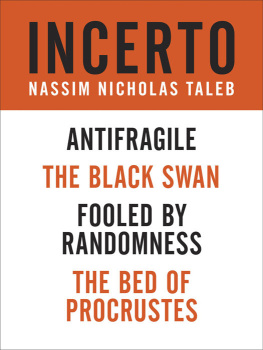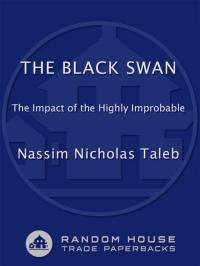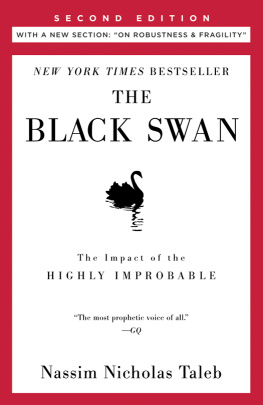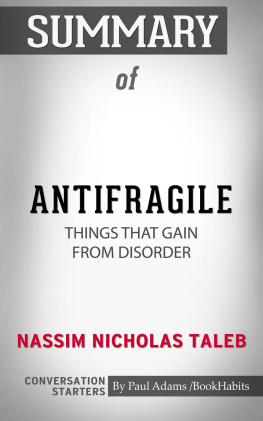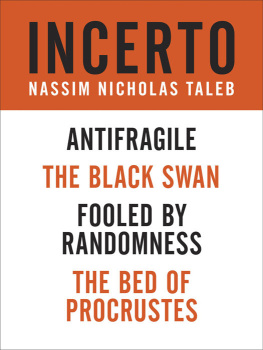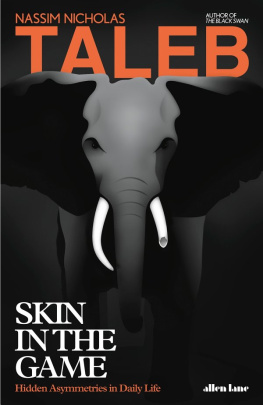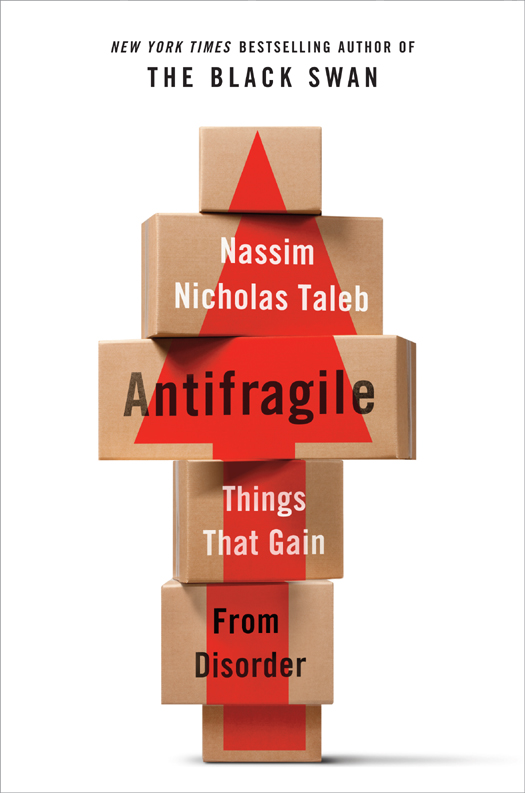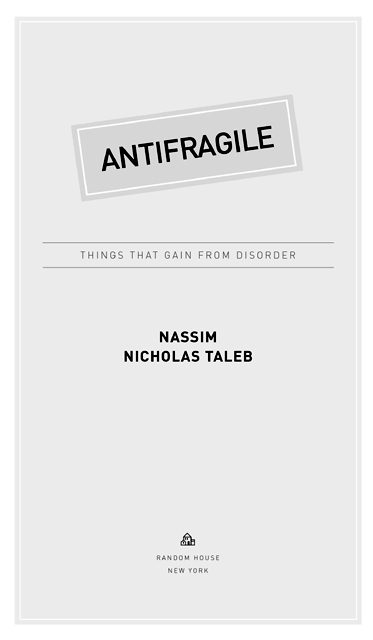Copyright 2012 by Nassim Nicholas Taleb
All rights reserved.
Published in the United States by Random House, an imprint of The Random House Publishing Group, a division of Random House, Inc., New York.
R ANDOM H OUSE and colophon are registered trademarks of Random House, Inc.
LIBRARY OF CONGRESS CATALOGING-IN-PUBLICATION DATA
Taleb, Nassim.
Antifragile : things that gain from disorder / Nassim Nicholas Taleb.
p. cm.
Includes bibliographical references and index.
ISBN 978-1-4000-6782-4
eISBN: 978-0-679-64527-6
1. Uncertainty (Information theory)Social aspects. 2. Forecasting. 3. Complexity (Philosophy) I. Title.
Q375.T348 2012
155.24dc23 2012028697
Cover design: Keenan
Cover Illustration: based on a photograph
Malerapaso/iStockphoto
www.atrandom.com
v3.1_r1
To Sarah Josephine Taleb
Contents

Chapter Summaries and Map

Boldface terms are in the .
. Explains how we missed the word antifragility in classrooms. Fragile-Robust-Antifragile as Damocles-Phoenix-Hydra. Domain dependence.
. Where we find overcompensation. Obsessive love is the most antifragile thing outside of economics.
. The difference between the organic and the engineered. Touristification and attempts to suck volatility out of life.
. The antifragility of the whole often depends on the fragility of the parts. Why death is a necessity for life. The benefits of errors for the collective. Why we need risk takers. A few remarks about modernity missing the point. A salute to the entrepreneur and risk taker.
THE PROCRUSTEAN BED
. Two different randomness categories, seen through the profiles of two brothers. How Switzerland is not controlled from above. The difference between Mediocristan and Extremistan. The virtues of city-states, bottom-up political systems, and the stabilizing effect of municipal noise.
. Systems that like randomness. Annealing inside and outside physics. Explains the effect of overstabilizing organisms and complex systems (political, economic, etc.). The defects of intellectualism. U.S. foreign policy, and pseudostabilization.
. An introduction to naive intervention and iatrogenics, the most neglected product of modernity. Noise and signal and overintervening from noise.
. Prediction as the child of modernity.
. Fat Tony, the smeller of fragility, Nero, long lunches, and squeezing the fragilistas.
. In which Professor Triffat refuses his own medicine and we use Seneca and stoicism as a back door to explain why everything antifragile has to have more upside than downside and hence benefits from volatility, error, and stressorsthe fundamental asymmetry.
. What to mix and not to mix. The barbell strategy in life and things as the transformation of anything from fragile to antifragile.
(The tension between education, which loves order, and innovation, which loves disorder.)
. Thales versus Aristotle, and the notion of optionality, which allows you not to know whats going onwhy it has been misunderstood owing to the conflation. How Aristotle missed the point. Optionality in private life. Conditions under which tinkering outperforms design. Rationalflneur.
. Asymmetric payoffs behind growth, little else. The Soviet-Harvard illusion, or the lecturing-birds-how-to-fly effect. Epiphenomena.
. The green lumber fallacy. Tension between episteme and trial and error, and the role through history. Does knowledge generate wealth, and if so, which knowledge? When two things are not the same thing.
. Rewriting the history of technology. How, in science, history is rewritten by the losers and how I saw it in my own business and how we can generalize. Does knowledge of biology hurt medicine? Hiding the role of luck. What makes a good entrepreneur?
. How to deal with Soccer Moms. The education of a flneur.
. Fat Tony argues with Socrates. Why cant we do things we cant explain, and why do we have to explain things we do? The Dionysian. The sucker-nonsucker approach to things.
. Convexity, concavity, and convexity effects. Why size fragilizes.
. The Philosophers Stone. Deeper into convexity. How Fannie Mae went bust. Nonlinearity. The heuristic to detect fragility and antifragility. Convexity biases, Jensens inequality, and their impact on ignorance.
. Neomania. Looking at the future by via negativa. The Lindy effect: the old outlives the new in proportion to its age. Empedocles Tile. Why the irrational has an edge over the perceived-to-be-rational.
. Medicine and asymmetry. Decision rules in medical problems: why the very ill has a convex payoff and the healthy has concave exposures.
. Medicine by subtraction. Introduces the match between individuals and the type of randomness in the environment. Why I dont want to live forever.
. The agency problem as transfer of fragility. Skin in the game. Doxastic commitment, or soul in the game. The Robert Rubin problem, the Joseph Stiglitz problem, and the Alan Blinder problem, all three about agency, and one about cherry-picking.
. Ethicalinversion. The collective can be wrong while individuals know it. How people are trapped into an opinion, and how to set them free.
. Conclusion.
. What happens when Nero leaves to go to the Levant to observe the rite of Adonis.
Prologue

I. HOW TO LOVE THE WIND
Wind extinguishes a candle and energizes fire.
Likewise with randomness, uncertainty, chaos: you want to use them, not hide from them. You want to be the fire and wish for the wind. This summarizes this authors nonmeek attitude to randomness and uncertainty.
We just dont want to just survive uncertainty, to just about make it. We want to survive uncertainty and, in additionlike a certain class of aggressive Roman Stoicshave the last word. The mission is how to domesticate, even dominate, even conquer, the unseen, the opaque, and the inexplicable.
How?
II. THE ANTIFRAGILE
Some things benefit from shocks; they thrive and grow when exposed to volatility, randomness, disorder, and stressors and love adventure, risk, and uncertainty. Yet, in spite of the ubiquity of the phenomenon, there is no word for the exact opposite of fragile. Let us call it antifragile.
Antifragility is beyond resilience or robustness. The resilient resists shocks and stays the same; the antifragile gets better. This property is behind everything that has changed with time: evolution, culture, ideas, revolutions, political systems, technological innovation, cultural and economic success, corporate survival, good recipes (say, chicken soup or steak tartare with a drop of cognac), the rise of cities, cultures, legal systems, equatorial forests, bacterial resistance even our own existence as a species on this planet. And antifragility determines the boundary between what is living and organic (or complex), say, the human body, and what is inert, say, a physical object like the stapler on your desk.


